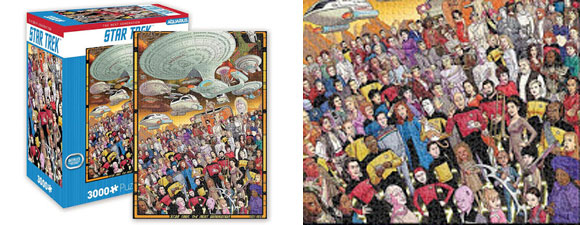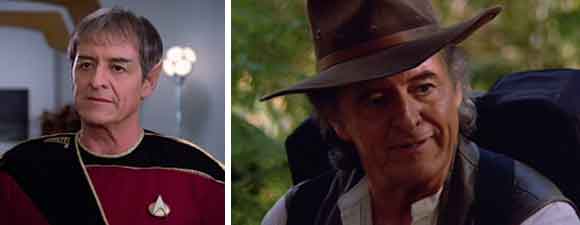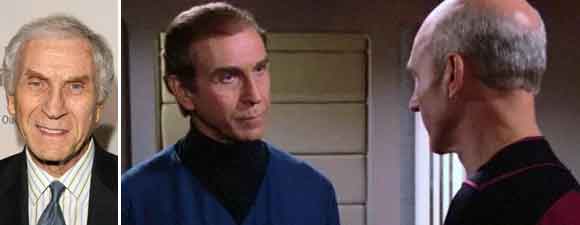Retro Review: Chain of Command
8 min readWhile newly assigned Captain Jellico tries to whip the Enterprise crew into shape for a confrontation with the Cardassians, Picard is caught on a secret mission, taken prisoner, and interrogated.
Plot Summary: Vice Admiral Nechayev comes aboard the Enterprise near the Cardassian border to tell Picard that she is there to relieve him of command. While Captain Edward Jellico, who has experience wrangling with the Cardassians, takes the ship into negotiations, Picard is sent to lead Crusher and Worf on a top secret mission to the Cardassian colony of Celtris III, where Starfleet believes they are developing a bioweapon with which Picard is familiar from his experiences aboard the Stargazer. The team finds that there are no weapons and Picard is taken prisoner, where the Cardassians first use truth serum, then sensory deprivation, to try to learn of Starfleet’s intentions concerning a border world claimed by both the Federation and the Cardassian Union. Picard reports honestly that he does not know, but the sadistic Gul Madred continues his interrogation. Meanwhile Jellico comes into conflict with several Enterprise officers over his stringent command style, but his aggressive negotiations with the Cardassians appear to be effective until Gul Lemec tells him that Picard has been captured and will be tried for espionage. In order to keep Starfleet blameless, Jellico insists that Picard was acting alone and refuses to risk a rescue, which infuriates Riker who is then relieved of duty.
Since Starfleet will not admit that a state of war exists, Madred is not required to obey the treaty governing the treatment of prisoners of war and tortures Picard, insisting that there are five lights behind him when there are in fact four and using pain to reinforce that message. The Enterprise crew determines that the Cardassians have been exposed to particles from the McAllister nebula and Jellico guesses that they have a fleet hidden there. Told by LaForge that Riker is the best pilot on board, Jellico reluctantly makes peace with Riker and asks him to take a shuttle and plant mines amidst the fleet. Then he warns the Cardassians that he will destroy their ships if they do not retreat. Lemec agrees to stand down, but Madred tells Picard that the Enterprise has been destroyed, Picard has been listed among the casualties, and the torture will continue indefinitely unless Picard agrees that there are five lights in the room. Before Picard can answer, Lemec comes in to tell Picard that he will be released. Picard shouts that there are four lights, but once he is returned to the Enterprise, he asks Troi to come to his ready room and tells her that not only was he willing to tell Madred what he wanted to hear to avoid further torture, but he actually believed that he could see five lights.
Analysis: “Chain of Command” aired as two separate episodes, but when I watched it with my family to review, we all agreed at the end of the first part that we couldn’t wait to see the resolution and put Part II on immediately after Part I ended. Several Star Trek two-parters suffer from a significant decline in the second half – the sixth season’s premiere, “Time’s Arrow, Part Two,” is one of those – but “Chain of Command,” like “The Best of Both Worlds,” lives up to its promise. There’s nothing extraneous in this double episode, nothing that feels tacked on to fill time; the pacing is perfect, with storylines that mesh and feed off one another, and the acting is some of the series’ finest, particularly from Patrick Stewart and guest star David Warner. Usually most of the praise heaped on the two-parter is reserved for the 1984-style torture sequences (done better here than in any film version I’ve seen of Orwell’s novel, though Michael Radford’s 1984 film of the same name seems an obvious point of reference, as does the novel itself in which the protagonist is forced to agree that two plus two equals five. Yet the military storyline, in which Jellico’s command style causes friction with Riker and Troi in particular, is also engrossing and actually leads to one visible change for the remainder of the series, for although Troi may not appreciate his lack of sensitivity to the crew’s feelings, she takes his order to dress professionally on the bridge to heart and wears a Starfleet uniform on duty thereafter.
We learned after the fact that “Chain of Command” was written to establish the Cardassians as adversaries to be reckoned with, since Deep Space Nine was in the works and the Cardassians were envisioned as the major villains. It’s entirely effective; while their first appearance in the fourth season episode “The Wounded” revealed that they could be duplicitous and brutal, it didn’t give any sense of the size of their empire or the danger they posed to outlying Federation worlds. Here they hatch an extremely complicated plot just to get Picard out of the picture, indicating that their intelligence as well as their resources make them far better prepared for a war than Starfleet. Picard seems to have been a pet project of Madred, whose interest in him is creepily personal. Madred wants to break Picard long after he realizes that Picard doesn’t have any Federation secrets he can use; even after he learns that the fleet has been discovered and Picard is scheduled to be released, he continues his torture, telling Picard lies that he knows will be revealed as such in a matter of minutes and demanding obedience just because he still can.
Why Picard? We never really get a clear answer, nor are we made to understand how Starfleet could commit a blunder of such magnitude, sending their flagship’s captain straight into a tailor-made trap with two of his own officers. I realize that Section 31 hadn’t been devised yet by the franchise’s writers, but surely Starfleet much have had some sort of internal intelligence operatives with specialized training for such an infiltration? I’d trust Worf as well as any security officer to defend my life, but Crusher is asked to go along to confirm the presence of a metagenic bio-weapon that would kill everything alive on a planet yet leave its technology intact – something that a qualified tech with a tricorder ought to be able to do as easily as a medical doctor. Why did Starfleet risk leaving the Enterprise hobbled by taking away not one but three senior officers on such a mission just as it was headed into negotiations to stop a war, bringing Cardassians on board? The decisions seem as hasty as Jellico’s seemingly arbitrary changes in the ship’s rotation schedule, the first of many points on which he and Riker clash.
That Jellico doesn’t mesh well with the bridge crew is obvious, yet he has a point when he tells both Riker and Troi in essence to stop whining and do their jobs. The two of them are concerned with keeping the crew’s routine undisturbed in the absence of Picard, as if the crewmembers are children facing a loss in the family, while Jellico sees a war brewing and doesn’t have any patience with Starfleet officers who need coddling. Jellico often comes in for a lot of criticism by fans, who echo Riker’s accusations that the temporary captain is a rigid, arrogant, closed-minded control freak, but I’m not sure any of those are fair. He’s had command of the flagship dropped upon him by an admiral who seems to expect that military force will be necessary, he wants to make sure the ship and crew are ready; if that means putting everyone on a different duty rotation, expecting that his orders will be obeyed without a discussion of people’s feelings, that seems quite reasonable. Riker has commanded the Enterprise himself on so many occasions that it’s not surprising he’d bristle at being pushed around instead of treated as an equal, which I think is the real cause of conflict here. It’s not that any of Jellico’s decisions are bad ones, it’s that he feels the need to assert his authority over Riker and Troi, whom Picard has treated as equals for years. In fact, Jellico makes all the right calls, stalling for time, figuring out what the Cardassians have been up to, swallowing his pride and putting Riker back on duty for the critical mission.
As for Picard, his greatest strengths include his ability to remain calm, to keep his temper, and to work logically through situations that are frustrating everyone around him. But none of those strengths are any use with Madred, who figures out after the truth serum that Picard can’t provide the intelligence information the Cardassian Union needs to take over the border worlds they claim. Madred is absolutely gloating that they set a successful trap for Picard – whether he learns anything of use from him seems almost beside the point. By the time he starts the torture, Picard knows that Crusher and Worf aren’t coming to his rescue any time soon – Crusher has, in fact, already made the decision to let Riker recover herself and Worf, leaving Picard’s fate in the hands of Jellico and the negotiators – with the implication that the pain could be endless. The scene in which the Gul lets his young daughter see a battered Picard is horrifying, though no more so than Madred’s claim that he’s already had Worf killed and will torture Crusher since Picard isn’t cooperating.
Knowing that the Gul is pitiable – that he is a terrified six-year-old inside – doesn’t make the pain any more bearable. Though the Gul will never know it, he has broken Picard by the time rescue arrives. But Picard knows it. In a way it’s more terrible than what the Borg did to him, which was an invasion of his biology, with no question about whether his strength of will could have held them off. He isn’t so disturbed by the knowledge that he would have told Madred anything to make the pain stop as by the fact that, in the end, he actually saw the five lights he had been ordered to say were there. I’m not sure his command style would be any less rigid than Jellico’s, now, faced with a new Cardassian threat.






